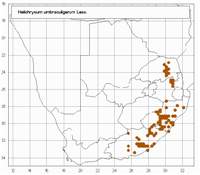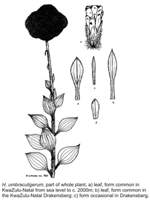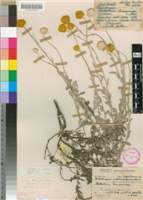Common names:
Keeribos, -kruie (A)
Origin of name:
umbraculigerum = umbrella bearing and woolly alluding to the shape and surface of the inflorescence; bearing woolly umbrellas.
Diagnostic characters:
Bracts yellowCompact flower heads, fused in an umbrella shape, cobwebby belowLeaves grey and velvety hairy, densely glandular
Description:
Tufted perennial herb, stems often decumbent and rooting, then erect to c. 1 m, young parts thinly grey-woolly, leafy. Leaves mostly 20-80 x 3-25 mm, becoming smaller upwards and passing into bracts, very variable in shape, ranging from linear-lanceolate to elliptic and tapering at both ends; or lanceolate- or oblong-spathulate to spathulate, acute or subacute, base slightly to much narrowed and ear-clasping; or ovate, elliptic-ovate to rhomboid-ovate and rather abruptly narrowed to a petiole-like ear-clasping base; upper surface with stout or delicate glandular hairs, erect or appressed, mostly cobwebby or thinly to thickly greyish white-woolly as well, lower surface often thickly greyish white woolly, or wool sometimes thin or wanting. Heads homogamous, cylindric, c. 3 x 1 mm, very many crowded and webbed together with wool forming a flattened, umbrella-like disc, the flattened branches of the cymose inflorescence visible through the wool. Involucral bracts biseriate, subequal, loosely imbricate, about equaling the flowers, not radiating, pellucid, canary-yellow, outer often golden-brown. Receptacle nearly smooth. Flowers 3-4 (-6), yellow. Achenes 0.5-0.75 mm long, barrel-shaped, with duplex hairs. Pappus bristles 0-7, shorter than corolla, scabrid, bases not cohering.
Flowering between January and April.
Distribution:
Grows in rough grassland or scrub, often on forest margins or in damp gullies and along streambanks. Ranges from the E. highlands of Zimbabwe to the Soutpansberg and the E. highlands of the Mpumalanga to KwaZulu-Natal, the Transkei and the Cape as far west as the Zuurberg near Port Elizabeth and the mountains about Graaff-Reinet.
Savanna, Grassland and Thicket Biomes.
Notes:
H. umbraculigerum displays remarkable variation in leaf shape, and there is some geographical partitioning of this variation. For instance, plants with ovate or rhomboid-ovate leaves much narrowed to a distinctly petiolar part are very nearly confined to KwaZulu-Natal, where they have a wide altitudinal range from near sea level to c. 2 000 m. But in the KwaZulu-Natal Drakensberg between c. 1 500 and 2 300 m, leaves may range from linear-lanceolate through all intermediates to ovate or rhomboid-ovate; narrow-leaved plants may occur in the same area as broad-leaved ones, but the former are generally found in wetter situations than the latter.
In Mpumalanga, Limpopo and Zimbabwe, leaves are mostly more or less elliptic, tapering at the base.
In the Cape, within an area roughly circumscribed by a line encircling Grahamstown, Cathcart, Barkly Pass, Qumbu, Port St Johns (Transkei) and East London, leaves tend to be oblong-spathulate, slightly narrowed towards the base then expanded and ear-clasping, and the flowers frequently lack a pappus. Elsewhere in the Cape, as well as in the area just mentioned, leaves may taper to a more markedly petiolar base but are never ovate nor rhomboid as in KwaZulu-Natal; the flowers generally have a pappus. We have not been able to trace the type specimen, but Lessing described the leaves as spathulate-oblong-obovate, slightly acute, much narrowed below, and the flowers as having a pappus. Krebs lived in Grahamstown for a while, and his specimen was possibly collected thereabouts.
The recognition of infraspecific categories is scarcely practicable, but the varietal name aequilatum (= H. coactum) applies to specimens with linear to narrowly elliptic leaves.
Taxonomy:
Literature:
Helichrysum umbraculigerum Less., Syn. Comp. 284 (1832); DC., Prodr. 6: 186 (1838); Harv. in F.C. 3: 236 (1865); Moeser in Bot. Jb. 44: 248 (1910); Batten & Bokelmann, Wild Fl. E. Cape Prov. 160, plate 127, 6 (1966); Hilliard, Compositae in Natal 153 (1977).
Type:
Cape, Krebs 147.
Synonym(s):
Gnaphalium umbraculigerum (Less.) Sch. Bip. in Bot. Ztg 3: 171 (1845). G. umbraculigerum var. a heterophyttum O. Kuntze, Rev. Gen. Pl. 3,2: 155 (1898).
G. umbraculigerum var. � aequilatum [O. Hoffm. ex] O. Kuntze, Rev. Gen. PI. 3,2: 155 (1898). Helichrysum umbraculigerum var. aequilatum (O. Kuntze) Moeser in Bot. Jb. 44: 248 (1910). Type: KwaZulu-Natal, Van Reenen's Pass, O. Kuntze s.n. (K, iso.).
H. coactum M. D. Henderson in Bothalia 6: 421 (1954). Type: KwaZulu-Natal, Bergville distr., Cathedral Peak Forest Research Station, Killick 1354 (PRE, holo. BM; K; NH; NU; S, iso.).
Vouchers:
Codd 2772 (NU; PRE); Hilliard 4970 (E; K; MO; NU; PRE; S); Hilliard & Burtt 7992 (E; K; M; NU; PRE; S); Pegler 675 (BM; K; NU; PRE); Schlechter 4733 (BM).

